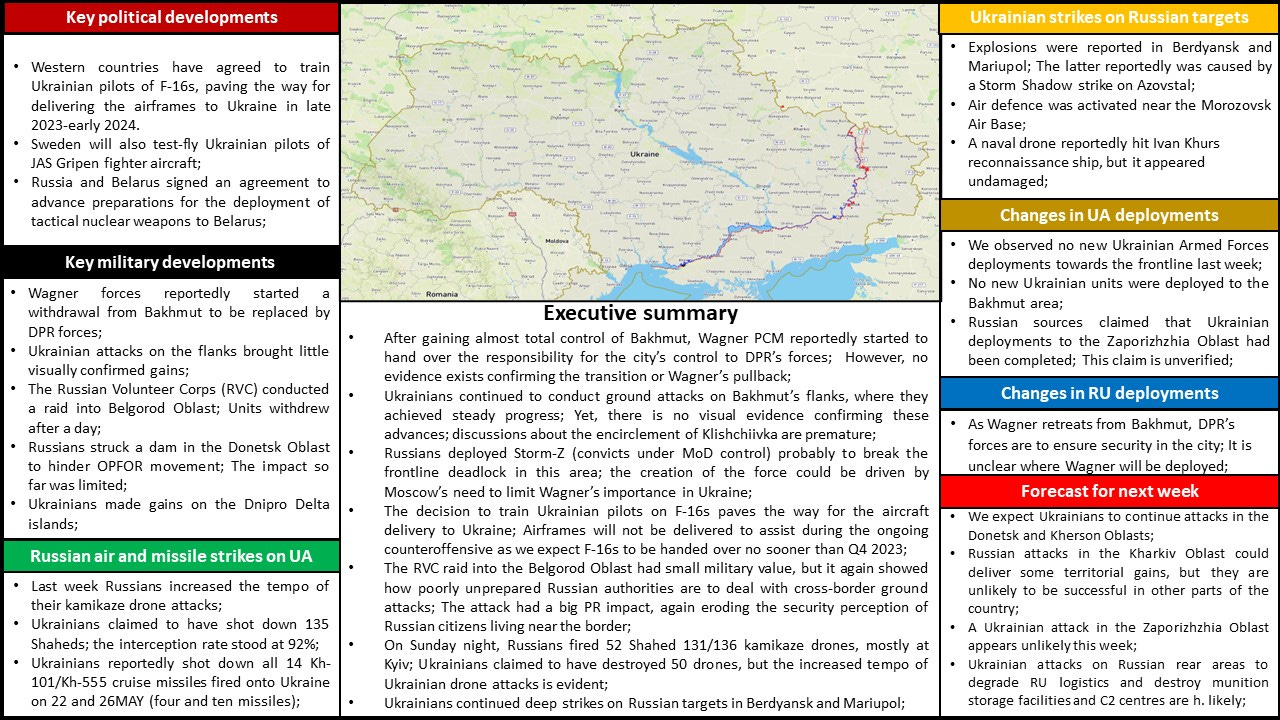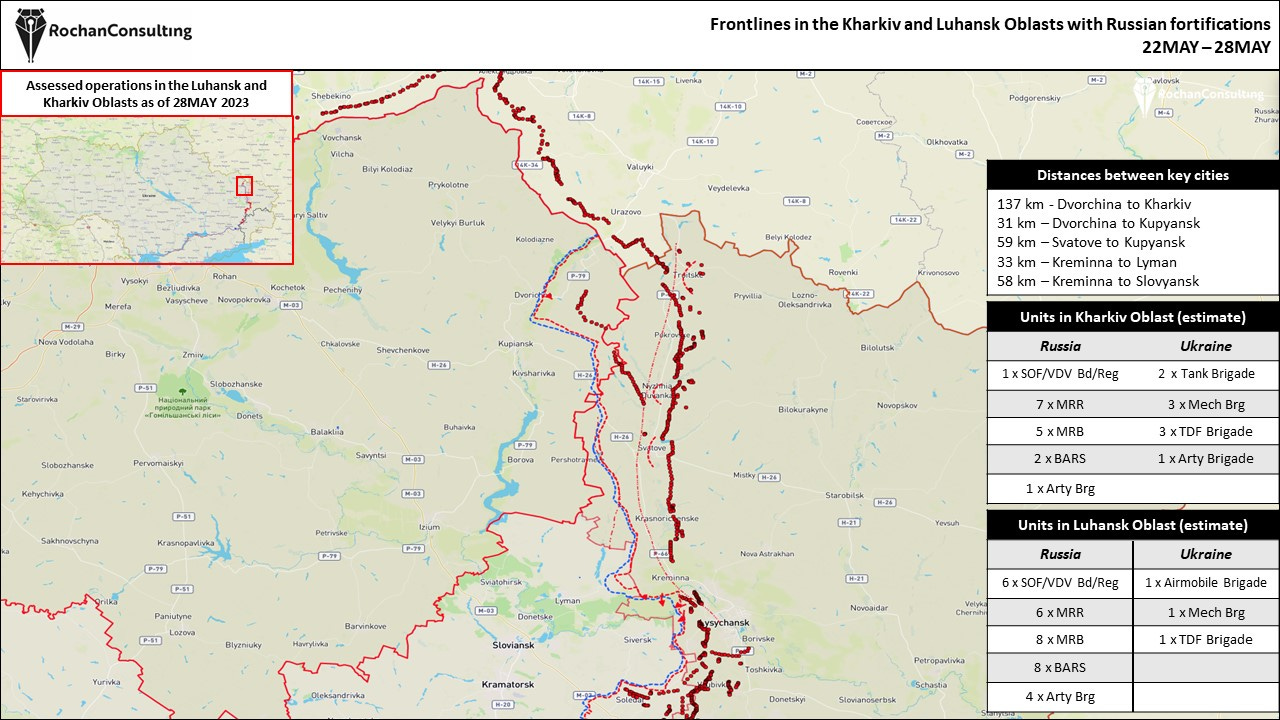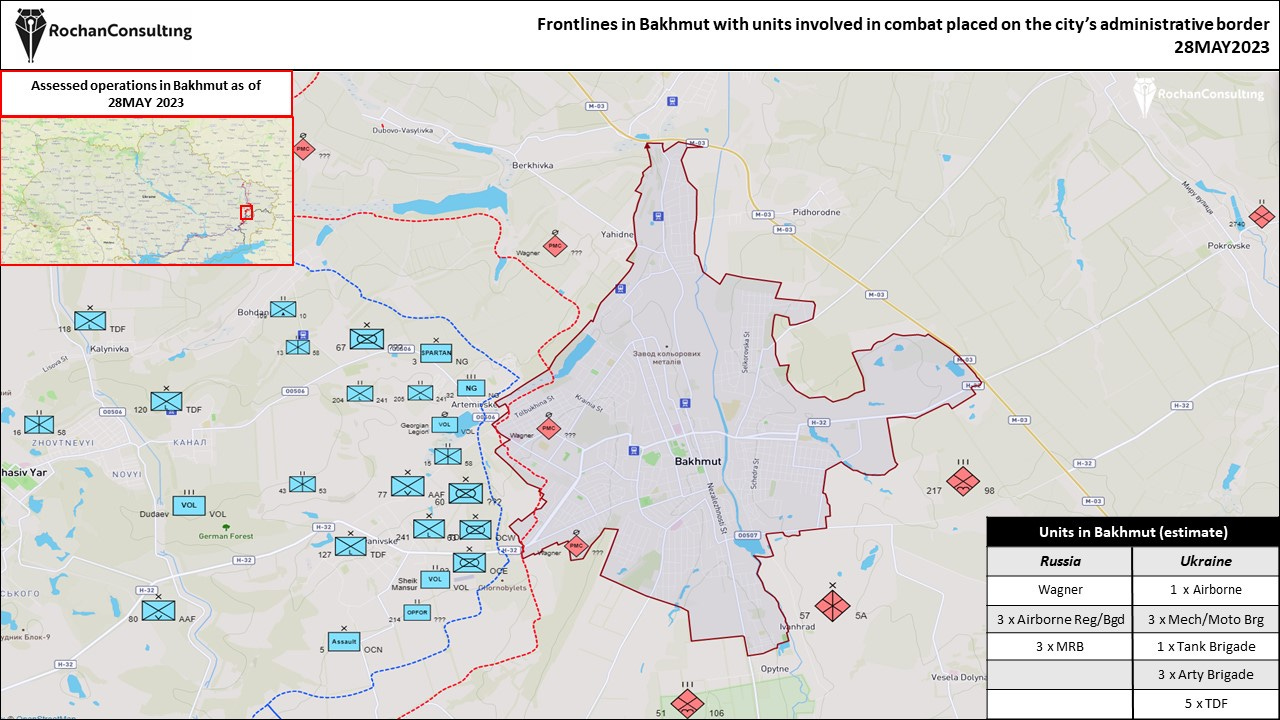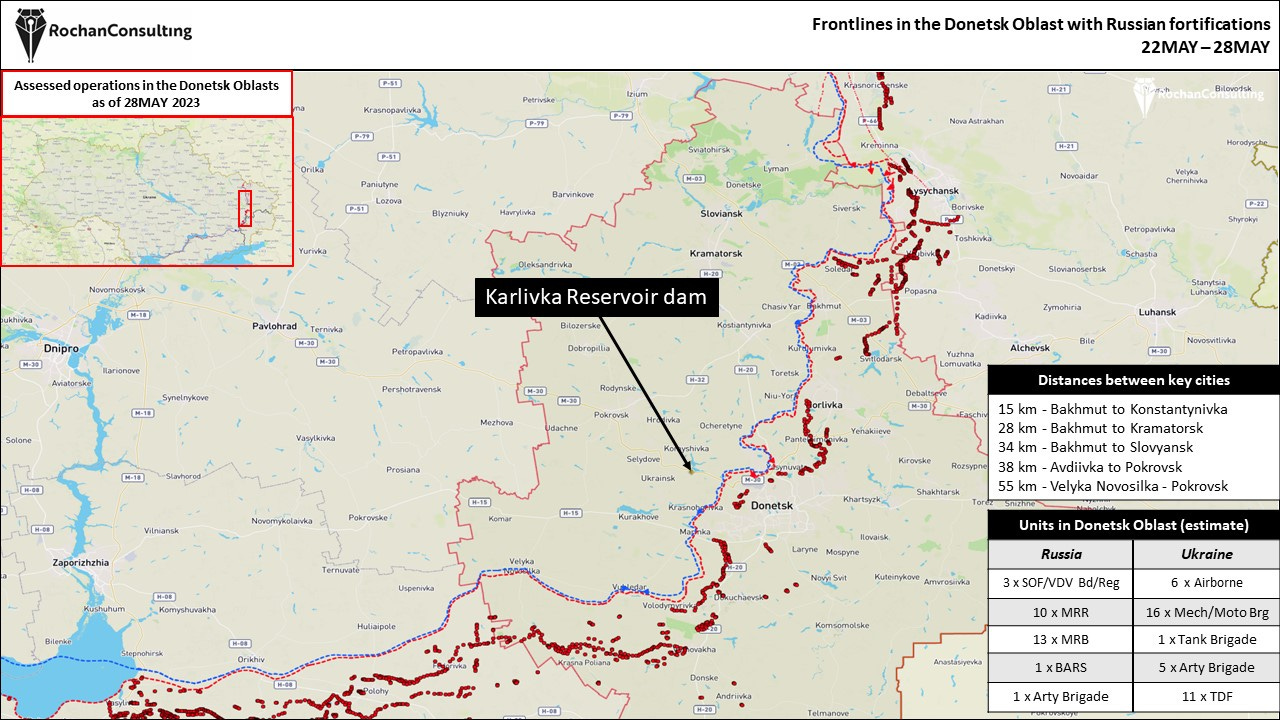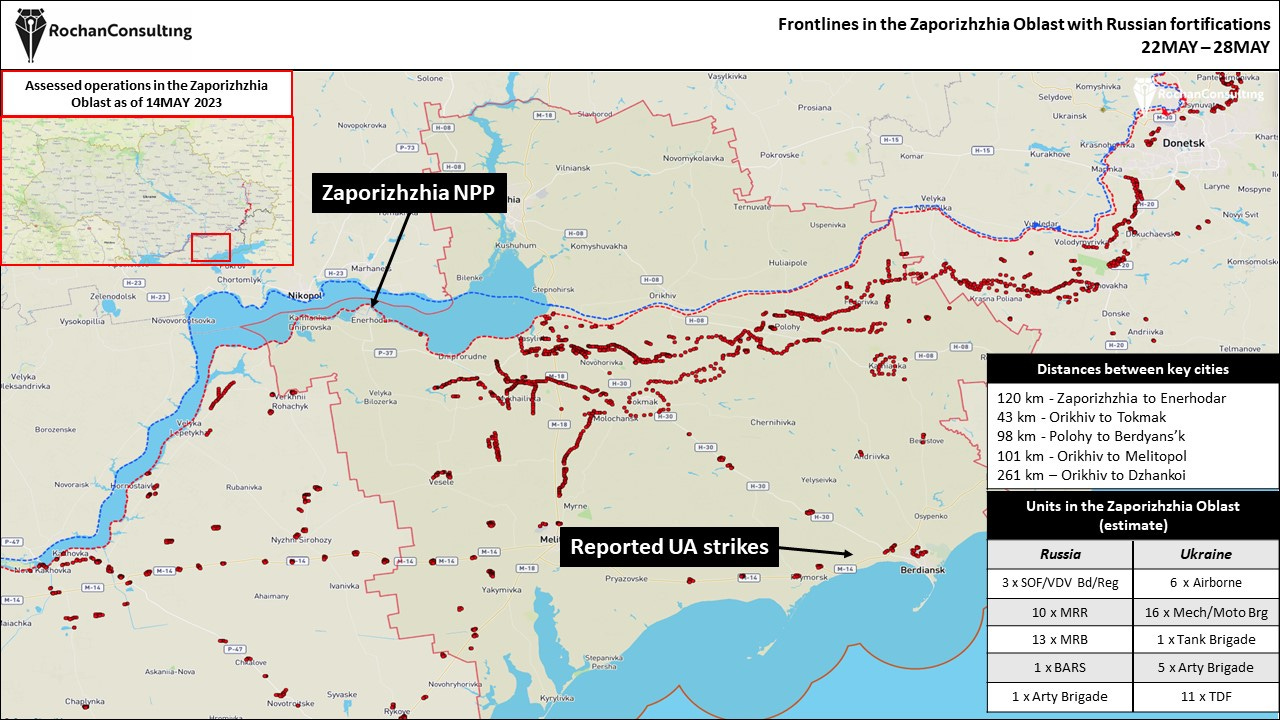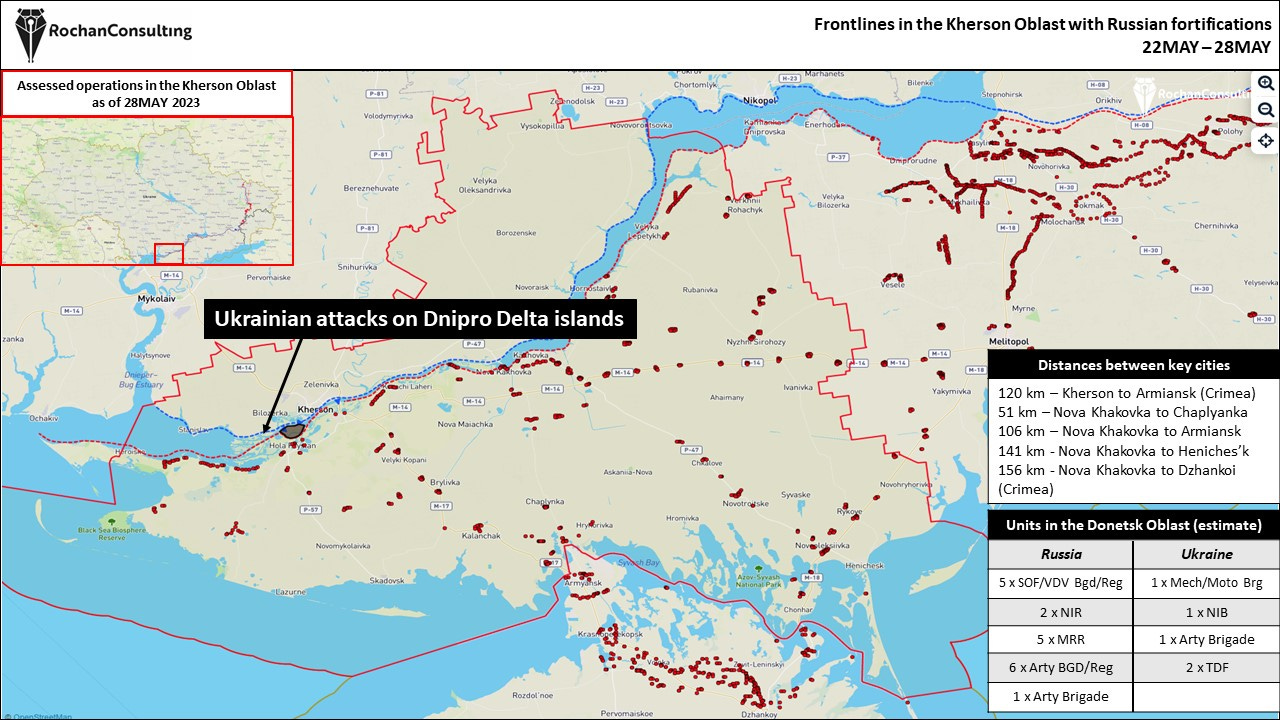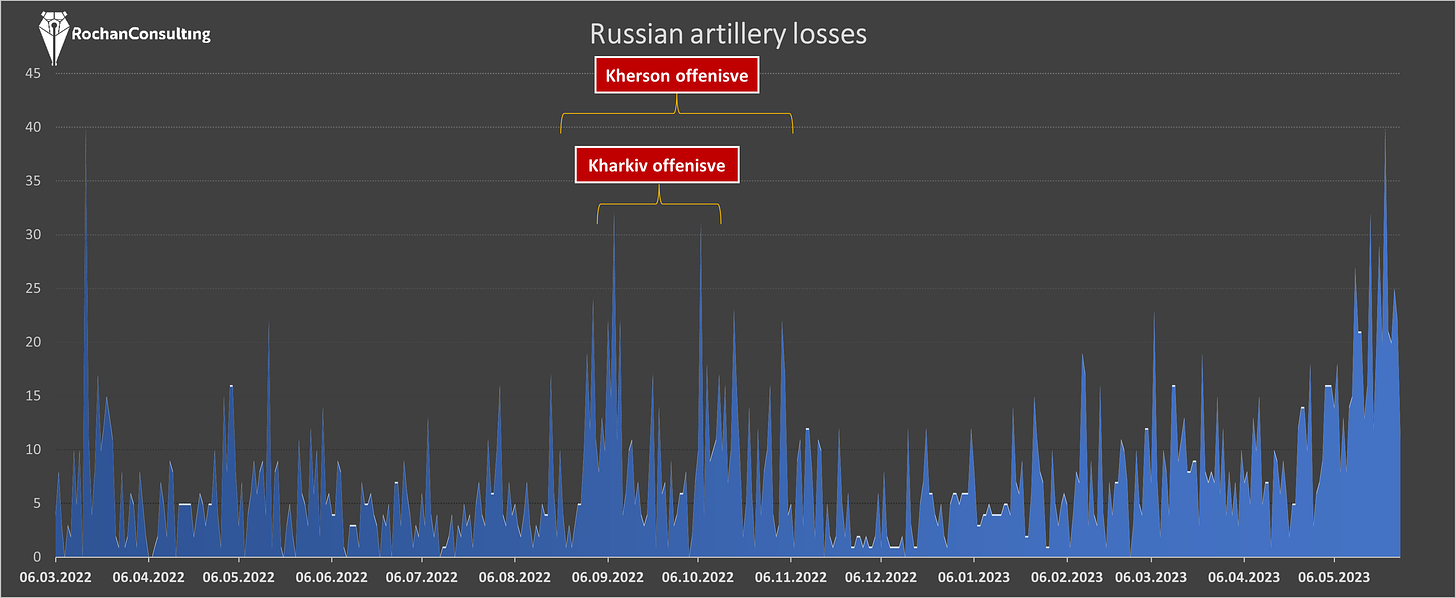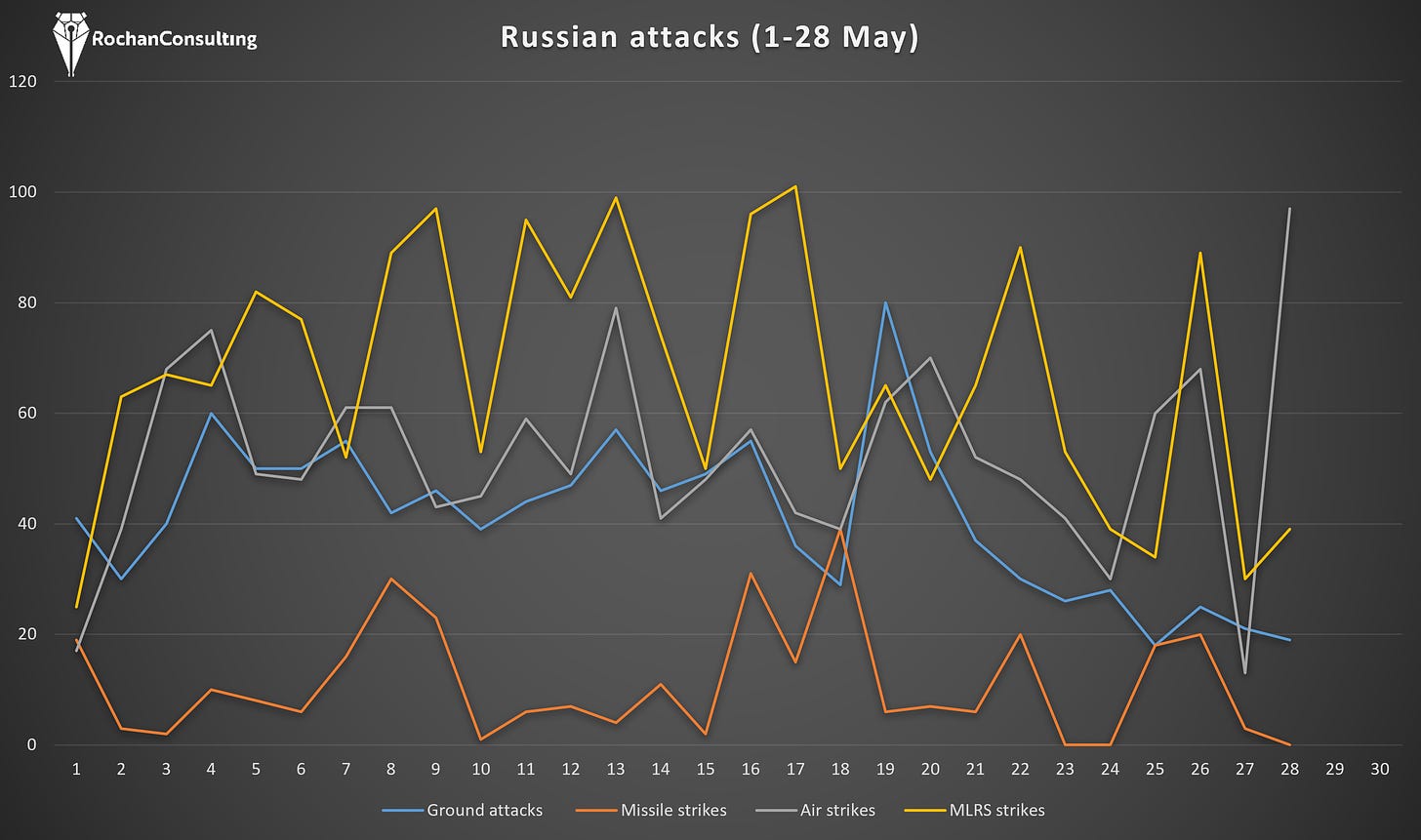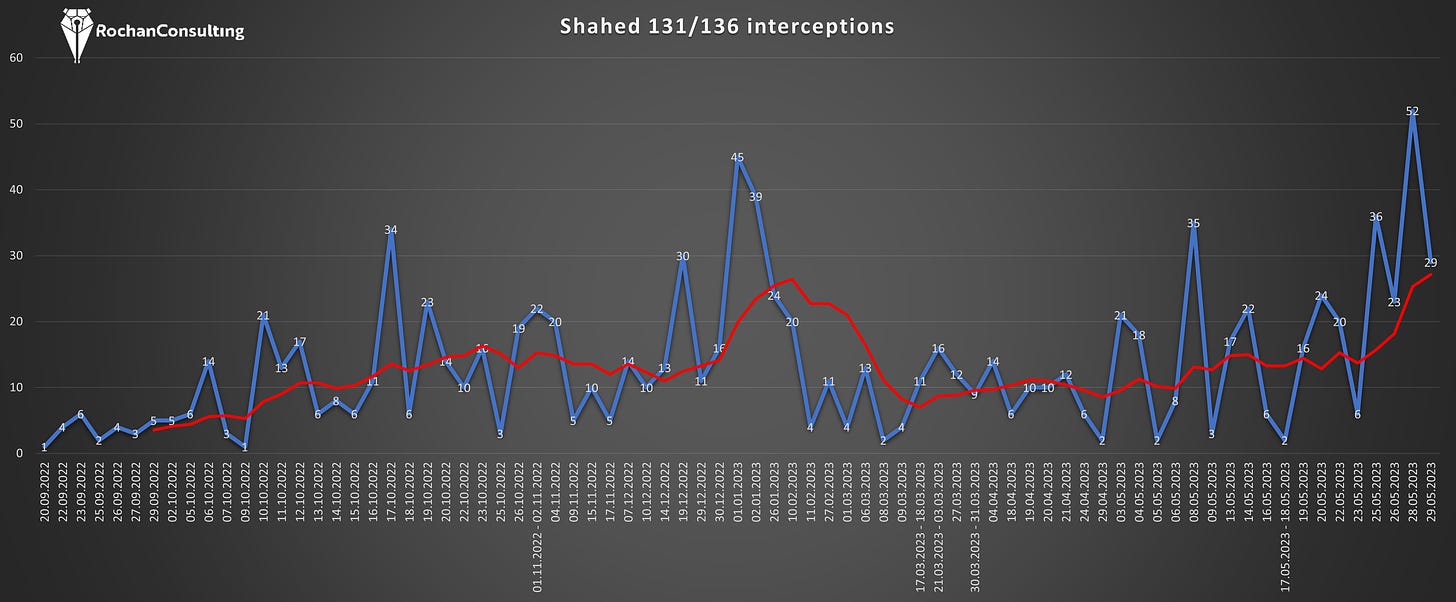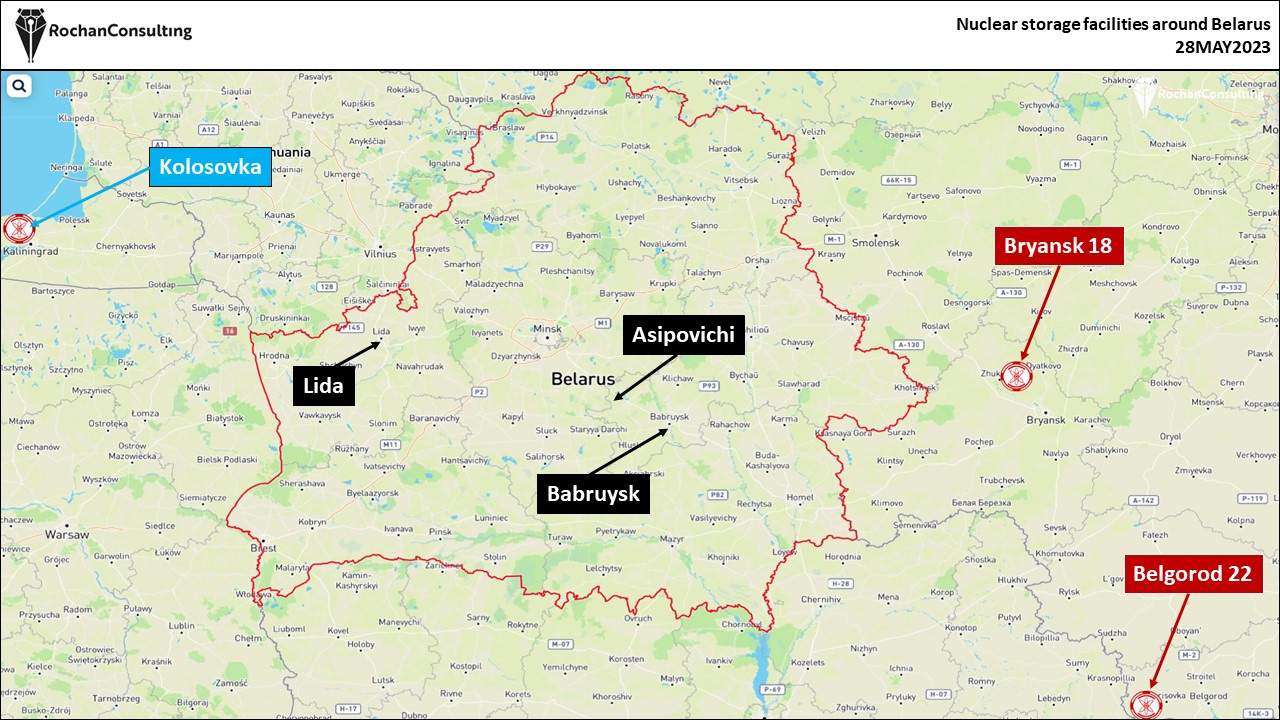Ukraine Conflict Monitor - 22 May – 28 May (Weekly update)
Situational report 22 May – 28 May
BLUF: The situation in Ukraine remained largely unchanged last week. Most fighting occurred near Masutivka in the Kherson Oblast, Bilohorivka in the Luhansk Oblast, near Bakhmut and Avdiivka in the Donetsk Oblast and on islands on the Dnipro Delta. The frontline, however, barely shifted. Russians significantly increased the intensity of kamikaze drone strikes.
Key takeaways from last week’s developments:
The previous week delivered little frontline changes in Ukraine; Most battles continued to occur in the Donetsk Oblast, where both sides conducted limited ground attacks; The frontline in other parts of the country barely moved; On the surface, the situation appears to have stabilised, but many indicators suggest we are getting closer to a big Ukrainian push;
No changes were reported in the Kharkiv Oblast, where Russians made no progress despite deploying Storm-Z troops;
In the Luhansk Oblast, Russians were mainly focused on the Bilohorivka area, where they made some unconfirmed gains; However, all Russian attacks were repelled in other parts of the region;
In the Donetsk Oblast, Russian attacks brought no frontline changes; Ukrainians may have progressed north of Avdiivka; A Russian attack on a dam on the Karlivka Reservoir will probably have a very limited impact on Ukrainian ability to support their forces near Pervomaiske and Marinka;
Having captured 99 % of Bakhmut, Wagner forces reportedly started transferring the responsibility for the city’s occupation to DPR forces; Ukrainians claimed to have made gains on northern and southern flanks, but many claims remained uncorroborated;
The situation in the Zaporizhihia Oblast did not change as both sides’ activities continued to be subdued; Russian sources claimed Ukrainian units had been deployed to staging areas, while Kyiv launched several deep strikes on Russian rear areas;
Ukrainians probably made some gains on the Dnipro Delta islands in the Kherson Oblast;
Although we noted no changes in the posture of the Belarusian Armed Forces, Minsk and Moscow signed an agreement on the deployment of nuclear warheads to Belarus;
Russians stepped up drone attacks, while Ukrainians reported a significant increase in the number of Russian field artillery systems destroyed;
A decision to provide F-16s to Ukraine could increase its air force’s capability in air-to-air combat, but they are only likely to be delivered to Ukraine in Q42023 at the earliest;
Russian Volunteer Corps launched a raid into Russia in the Belgorod Oblast, once again undermining Moscow’s assertions that the border is secure and that its ability to protect Russian territory;
Executive summary
Although from operational and strategic perspectives, last week did not bring any significant changes in Ukraine, both sides stepped up efforts to degrade OPFOR capabilities.
Wagner forces reportedly started pulling back from Bakhmut, where they are to be replaced by Donetsk People’s Republic (DPR) formations, which were in turn diverted from Avdiivka. It still remains unclear what will happen to Wagner, but attacks towards Chasiv Yar appear unlikely, but so does the total withdrawal from Ukraine. In fact, we expect the organisation to reappear in other parts of the front. At the same time, Russians stepped up missile drone strikes on targets across Ukraine. 48 Shahed 131/136 drones were intercepted two weeks ago, compared to 65 last week. On the night of 28/29MAY alone, Russians launched 54, and Kyiv claimed 52 were downed, bringing the total to 117 interceptions between 22-29MAY. Ukrainians claimed that Russians recently significantly improved the effectiveness of their missile attacks as some strikes affected Ukraine’s war effort. However, as Kyiv refuses to provide any information about the damage caused by these strikes, it is difficult to assess the scale of the devastations or their long-term impact on Ukraine’s war posture. Nevertheless, it means that Russians adjusted to the threat posed by the Ukrainian new air defence umbrella and are at least partly able to circumvent western-supplied systems.
Last week, Russians also hit a dam on the Karlivka Reservoir. Russians probably sought to degrade the Ukrainian ability to sustain their forces between Pervomaiske and Marinka. The most recent reports from this area indicate that this objective was not attained.
Ukrainians continued operations around Bakhmut. Official Ukrainian military sources claimed daily advances. However, there is little visual evidence to support these assertions. We assess that Ukrainians did not significantly strengthen their forces near Bakhmut, let alone with units equipped with Western-supplied kit. It means that Kyiv does not plan any significant actions around Bakhmut in the near future. It also confirms our last week’s view on General Syrsky’s comments about the operational environment of Bakhmut – not only doesn’t Kyiv have enough forces in the area for this mission, but the currently deployed forces lack heavy armour and momentum to pursue such a goal. While we do not exclude the possibility of Ukrainian gains around Bakhmut, Kyiv is far away from retaking the initiative in this area.
Speaking of the initiative, Ukrainians made some gains in the Cherkessky Island in the Kherson Oblast, on the river’s left bank. This progress indeed brings them closer to crossing Dnipro. That said, the terrain in this particular area is particularly hard for conducting and sustaining attacks on Russia-controlled parts of the Kherson Oblast, so it is not yet obvious whether Kyiv’s ambition is to establish a permanent presence near Zabaryne. These attacks could be a part of battle-shaping efforts forcing Russians to defend the parts of the front where the counteroffensive would not occur. We expect mixed signals from Ukrainians, although the focus on southern parts of Ukraine is clear. Last week, Ukrainians launched several missiles on Russian targets in Mariupol and Berdyans’k, probably hitting command centres, logistics facilities, and troop deployment areas.
But the most important, yet short-lived, event occurred in the Belgorod Oblast, where the Russian Volunteer Corps (click here for more information about the corps) personnel launched a raid on the border crossing near Kozinka on 22 MAY. Not only did Ukrainians capture the crossing, but they also pushed towards Glotovo, with smoke seen also seen over Gora Podol, some seven kilometres from the border. If Gora Podol was indeed reached, then the attackers were some ten kilometres from the Belgorod-22 national-level nuclear storage site (see information about Belarus). Following the incursion, the area under RVC control was announced as “demilitarised”. Ukrainians denied involvement in the attack, while Sergei Shoigu, Russian Minister of Defence, claimed that the attackers lost 70+ men during the raid. However, our sources on the Ukrainian side stated that the RVC troops lost fewer than ten men.
By any count, the attack was “light”. RVC sent in at least two tanks, an APC and several other lightly armoured vehicles, such as US-supplied MRAP vehicles. But it was enough to send shockwaves across the Russian political-military establishment and social media. This led to bizarre scenes where the Chief of Staff of the Russian Ground Forces, Colonel General Aleksandr Lapin, personally led Russian troops into action near Glotovo. On the civilian front, Belgorod Oblast Governor Vyacheslav Gladkov announced the creation of seven territorial defence battalions for a total of 3,000 men.
Interestingly, it had been the second time Gladkov made this commitment (previously in December), so failures to respond to the growing threat of cross-border attacks were likely common. In the meantime, regional authorities spent more than USD132 million to construct fortifications in the Belgorod Oblast to hinder the movement of Ukrainian forces in the oblast. However, while “dragon’s teeth” are good against tanks, their utility in stopping fast-moving MRAP vehicles that can bypass fortifications at speed is questionable. Lastly, the attack confirmed another Russian weakness. The border areas are poorly defended by regular Russian units. Whether the raid will result in the redeployment of some forces and capabilities to the border remains to be seen. But to deter similar attacks in the future, Moscow will need to deploy battalions across the entire border, from Novye Yurkovichi to Verigovka. It is unlikely there is a free capacity for such missions.
Ukraine battle map
Please click here to access our interactive map.
The situation at selected axes and directions
Kharkiv direction
As expected, last week did not bring any changes to the Kharkiv Oblast. The frontline remained deadlocked as limited Russian attempts to capture new territories were repelled. Most attacks again occurred near Masiutivka, which despite Russian reports from two weeks ago, remained under Ukrainian control last week. Russians maintained a high attack tempo in this area, constantly looking for any weak spots in Ukrainian defensive lines that could be exploited. However, neither Ukrainian nor Russian sources reported any frontline changes in this sector.
That said, Russians probably reinforced their positions near the village. Ukrainian bloggers claimed that Moscow deployed its own “Storm-Z” units to the area. These units comprised convicts not previously signed up to fight under the Wagner PMC flag. As such, “Storm-Zs” were formed to oppose the Wagner, decrease the number of personnel Wagner could recruit and thus limit its impact on the battlefield. Storm-Z personnel sign contracts with the Ministry of Defence (MoD) while its units are embedded within the army structures. Ukrainians also maintain that Storm-Z units are already deployed in this direction, but their strength is currently unknown.
The same source claimed that Russian aviation increased the pace of its operations in the Kharkiv Oblast along the frontline to monitor the movement of Ukrainian forces. These two events combined suggest that Moscow is either concerned about a Ukrainian counterattack in the Kharkiv Oblast, hence reinforcements, or they consider the area to be relatively poorly defended with high chances of success of its own attacks.
No changes were reported near Hryanykivka and Krohmalne.
Last week, Russians did not undertake any ground attacks from Russia proper into the Kharkiv Oblast. But, they continued heavy artillery strikes on civilian infrastructure targets across the region, hitting Tsyrkuny, Vovchansk, Chuhuiv and Kozacha Lopan. Lyptsi, Vovchansk and Velykyi Burluk.
In Kupyansk, for instance, at least 14 private residential buildings and facilities were damaged by the MLRS fire on Tuesday.
The Russian MoD reported several strikes in the Kharkiv Oblast. The ministry claimed to have destroyed six Ukrainian observation posts and hit the concentration area of the 14th, 92nd Mechanised Brigade and Territorial Defence units using Su-34s.
Ukrainians also reportedly lost a Mi-8 near Lozova.
Luhansk direction
Likewise, no changes were reported in the Luhansk Oblast. The situation there remained largely stable despite Russian continued attacks, especially near Bilohorivka and Nevske.
Artem Lysohor, the Luhansk military administration head, stated last week that “panic had increased among the collaborators in the region”, some of whom had already left the region. He also added that medical assistance to the general population was limited as the priority was given to uniformed personnel. Russians also stepped up efforts to track and detain pro-Ukrainian citizens who might pass on information about the movement of Russian forces to Ukrainians.
The frontline remained unchanged in the Svatove area, while some limited Russian assaults near Stelmakhivka were repelled.
No changes occurred near Novoselivske and Kuzemivka, where positional battles and artillery exchanges continued.
No changes occurred near Makiivka, Ploshchanka and Chervonopopivka areas.
The same pertains to Torske and Terny. When it comes to Nevske, early in the week, a Russian source claimed that the attackers captured new positions near the village. However, this information was not independently confirmed. Nevertheless, Ukrainian and Russian reports confirmed a high Russian attack tempo in this sector throughout the week. On 24MAY, Artem Lysohor claimed that Russians fired ten times on the village on Tuesday, while 51 strikes were aimed at nearby areas.
No confirmed changes occurred near the Kreminna area, where positional battles continued near Dibrova and the Serebryanysky forest.
In the Luhansk Oblast, the centre of gravity is centred around Bilohorivka, where according to Roman Vlasenko, the Severodonetsk Administration Head, the bulk of Russian forces were deployed. However, despite this concentration of units and efforts to break through Ukrainian lines for several weeks, Russians made no confirmed territorial gains. The village was under Ukrainian control as of Sunday, 28MAY. Vlasenko also noted last week that Russians continued to “encourage” Ukrainians to apply for Russian passports, but these efforts do not bring desired results. Despite this, Russians conduct daily ground assaults on the village.
We are uncertain about the number of Russian artillery strikes in the Kreminna-Lyman direction. Two weeks ago, this axis remained the heaviest shelled area in Ukraine. According to Serhiy Cherevaty, the Eastern Group of the Ukrainian Armed Forces spokesman, on 21MAY, Russians fired 552 times at Ukrainian positions and 413 times at 24MAY, which indicates that the intensity of the attacks remained high. However, it is unclear whether this trend was maintained throughout the week.
On the other hand, Russians continued to claim various successes in the Luhansk direction. According to the Russian MoD, the movement of the Ukrainian 66th Mechanised Brigade, 25th Airborne Brigade and 95th Airborne Assault Brigade were interdicted near Nevske and Torske.
The 81st Air Mobile Brigade and 63rd Mechanised Brigade suffered casualties from artillery fire near Toretsk and the Serebryansky forest area.
Airstrikes hit Ukrainian concentration areas and ammunition depots in the Lyman direction.
(We give medium confidence to the number of combat units displayed on our maps. A brigade/regiment deployed near the frontline does not mean the unit is at full strength. In fact, many Russian formations deploy only one or two battalions. The data on Russian fortifications comes from Brady Africk).
Donetsk Oblast Direction
Despite ongoing battles near Bakhmut, the overall situation in the Donetsk Oblast remained largely unchanged and relatively stable. Battles continued along the entire frontline, but the Russian and Ukrainian ability to tilt the balance in their favour was still absent.
Let’s take a closer look at the frontline. No changes occurred near Spirne, Verkhnokamyanske and Vyimka. The 54th Separate Mechanised Brigade released a video showing the destruction of a Russian T-90M “Proryv” MBT in Spirne. The video does not speak well of the professionalism of Russian tankmen. Leaving a tank in such a position for an extended period will undoubtedly lead to its detection and at least a destruction attempt. In this case, Ukrainian drone operators were successful.
In mid-week, Russians launched several attempts at Ivano Dariivka, but no evidence exists confirming their forward movement.
Further south, the frontline remained stable in Vasiukivka, Fedorivka, Rozdolivka, and Vesele. Positional battles continued near Sakko and Vantseti. Neither Russian nor Ukrainian sources reported changes near Berkhivka, Bohdanivka, and Hryhorivka.
However, on Friday, Ukrainians reportedly liberated several positions on the dominant heights and advanced to a section of the M03 road and towards Orikhovo-Vasylivka. However, by any measures, this progress was minimal. Another source added that the Russian units defending this area were forced to retreat 1,000 meters northeast. In general, all reports from Ukrainians deployed around Bakhmut indicate they progressed more than 2,000 meters on the city’s flanks last week. However, as stated, we don’t know whether they referred to north, south or both. Ukrainians also provided no evidence to allowing to verify their gains.
Uncorroborated reports suggested Ukrainians made progress near Yahidne.
Also in mid-week, there was a Russian attempt to attack Ukrainian positions near Khromove, which led to no frontline changes in this area.
Ukrainian sources continued to assert that the Ukrainian Armed Forces controlled several buildings in Bakhmut, which is probably true. Their presence, however, is limited to a petrol station and a small foothold near the Aeroplane statue.
Still, these areas offer no staging ground for counterattacks back towards the city. Regardless, Russians control 99% of Bakhmut. However, by Friday, Wagner units started leaving the city. Rainy weather also limited ground attacks in the second half of the week.
No attacks toward Chasiv Yar were reported.
A Russian source claimed that Ukrainians lost 55,000 men killed near Bakhmut since FEB2022, which is an odd statement as the battle for Bakhmut commenced during the summer of 2022.
Ukrainians also advanced towards Klishchiyivka from Stupochky, crossing the Severskyy Donets-Donbass canal. A Russian source claimed that Russians might soon conduct a larger pullback in this area due to a threat of encirclement.
According to Serhiy Cherevaty, the Eastern Group of the Ukrainian Armed Forces spokesman, the Ukrainian units continued pushing back the Russian troops near Bakhmut. However, we see a continuation of last week’s trends on the Ukrainian side. Ukrainians assert they have progressed, but no visual evidence confirms their advances. As a result, despite these pronouncements, we have not moved the frontline in the Bakhmut area for a couple of weeks.
Early in the week, Russian troops attacked towards Novokalynove. Previously, on 19MAY, Russians also reportedly made some gains near a rail line. However, on 22MAY, Ukrainian troops liberated several positions in this area.
Ukrainians also noticed an increase in the number of fortifications to the north and south of Donetsk. A probable explanation behind this decision is Russian concern about a Ukrainian counterattack seeking to capture Donetsk and neighbouring areas. However, we currently assess the minimal likelihood of such urban battles initiated by Kyiv’s forces.
Neither Russian nor Ukrainian sources reported changes near Keramik, Berdychi, Stepove and Kruta Balka.
Russians attacked Ukrainian positions southwest of Avdiivka, but they delivered no results. In fact, Russians may abandon their plans to capture the city. A Ukrainian source claimed early in the week that Moscow had diverted the 1st Army Corps (DPR) from Avdiivka to Bakhmut to replace Wagner PMC fighters there.
On Thursday, Russians destroyed the Karlivka Reservoir dam using an S-300 missile (according to the Ukrainian General Staff), putting Halytsynivka, Zhelanne-Pershe and Zhelanne-Druhe under threat of flooding. Russians probably sought to hinder the movement of Ukrainian forces and the logistics support for units operating in the area. Pro-Russian sources immediately provided maps showing the “consequences” following the dam’s destruction. Russians claimed that Ukrainian logistics feeding military presence near Pervomaiske, Marinka, Kurakhove, and Krasnohorivka could be impacted. So far, the impact on the movement of Ukrainian forces in this area appears limited.
Last week, Russians also conducted limited attacks near Severne, but they probably made no gains in this area. Ukrainian sources did not report changes. No changes occurred near Pervomaiske, Tonenke and Nevelske.
On 22 MAY, a Ukrainian source said that Ukrainian troops counterattacked near Krasnohorivka and liberated several positions near the railway. Russian sources confirmed the counterattack but provided no details about this event.
Russians also attacked Ukrainian positions near Novomykhailivka and Marinka, but the frontline remained unchanged.
Neither Russian nor Ukrainian sources reported changes near Pobieda and Vuhledar.
Zaporizhzhia direction
Last week did not bring any changes to the situation in the Zaporizhihia Oblast. In fact, based on reports from Ukrainian and Russian sources, the intensity of ground attacks visibly decreased.
Ukrainians reported that the number of checkpoints in the occupied parts of the oblast increased in recent weeks as Russians stepped up efforts to find Ukrainian partisans who might want to infiltrate the frontline and conduct attacks in Russia’s rear.
A Russian source claimed last week that Ukrainian units were ready to start the counteroffensive in the region, but it failed to provide any evidence to back these claims. Two weeks ago, the same source stated that the Ukrainian grouping of forces in this area reached more than 50,000 men. We cannot confirm the veracity of these claims as no videos or images exist showing the deployment of Ukrainian forces en mass into the Zaporizhzhia area.
According to Energoatom, a state enterprise operating all nuclear power plants in Ukraine, Russians shelled the Zaporizhzhya Nuclear Power Plant (ZNPP) on Monday, causing a blackout and forcing the NPP to switch to emergency diesel generators to sustain its work.
Ukrainian military intelligence sources stated last week that Russians might organise a large-scale provocation to imitate an accident at the NPP to provoke the international community to conduct a detailed investigation during which all hostilities in the region will be suspended. This event is supposed to give Moscow more time to prepare defences and its forces for the Ukrainian counteroffensive.
Based on Ukrainian sources, Russians lost a Su-25 near Melitopol, although it is not clear how it may have been shot down this deep into Russia-controlled territory. Nevertheless, based on satellite imagery, we can confirm that the Su-25 crash-landed at the Melitopol Air Base, but the cause of the incident was unknown.
Speaking of deep strikes, explosions were again reported on Friday in Berdyasnk, where Ukrainians reportedly hit ammunition, fuel, and lubricants storage facilities. A civilian airfield used by Russian forces in Pryazovske was also hit.
A similar event occurred in Mariupol’s Azovstal, where a Russian base was located.
Kherson direction and Crimea
Last week delivered no changes in the Kherson Oblast. Both sides continued to limit their actions to artillery strikes and infiltration attempts of the Dnipro Delta islands. However, we must admit that Russians became visibly less active in the latter operations over the past few weeks.
The Russian journalist claimed that Russian artillery conducted successful strikes on Stanislav, Veletenske, Dniprovske, UAF positions on Velykyi Potyomkin Island, Antonivka, Lvove, Kozatke, Beryslav, Zolotaya Balka and the city of Kherson. He added that Ukrainian troops were concentrated in these areas to conduct river-crossing operations.
Ukrainians also reportedly tried to gain a foothold on Cherkessky Island opposite the Russian troops-controlled village of Zabaryne. This development, if confirmed, shows the expansion of Ukrainian efforts to control the river delta and decrease river crossing time over Dnipro. Russian sources also added that Russian aviation is active along the river, where they conduct strikes on Ukrainian positions.
The Ukrainian General Staff also reported that Russians deployed some 300 personnel onto the Dzharylgach Island.
The Southern Operational Command claimed that between 22-26MAY, Russians fired a total of 1200 shells on Ukrainian targets. Although, as we stated previously in the UCM, the intensity of artillery fire is high at the beginning of the week, steadily decreasing as the week goes on. Indeed Russians fired 430 shells on Monday and 280 on Thursday, and 250 on Friday. The number of artillery strikes also decreases from 70 on Monday to 57 on Friday.
Despite this deterioration of the security situation and the probable Ukrainian attack in southern Ukraine, Serhiy Khlan, the Kherson Oblast Administration Advisor, said that the Kherson Oblast occupation authorities were preparing for the autumn regional elections. It is unclear what will be the subject of the vote and when it will occur.
Summary of losses
According to the Russian Ministry of Defence, since the start of the war, Ukraine has lost 429 aircraft (+1), 235 helicopters (+1), 4,357 UAVs (+112), 424 anti-aircraft missile systems (launchers?)(0), 9,322 tanks and other armoured combat vehicles (+53), 1,100 MLRS launchers (0), 4,924 field artillery guns and mortars (+53), as well as 10,506 units of special military vehicles (+141).
According to the Ukrainian General Staff, Russia lost (eliminated) 206,600 personnel (+3,440), 3,797 tanks (+14), 7,456 armoured combat vehicles (+58), 3,425 artillery systems (+167) and 574 MLR systems (+10), 329 anti-aircraft systems (+2), 313 aircraft (+5) and 298 helicopters (+4), and 2,993 UAVs (+171), 6,192 vehicles and fuel tanks (+77), 1,056 cruise missiles (+45), 18 warships and boats (0) and 451 special vehicles (+26).
(Numbers in parentheses denote a weekly change)
As shown in the chart above, the Ukrainian General Staff reported a significantly increased number of destroyed Russian artillery systems, including gun and rocket systems, in recent weeks. It is unclear where this surge comes from. Still, it is possible that as a part of Ukrainian preparations for the counteroffensive, Ukrainians increased efforts to find and disable Russian artillery systems.
Russian air and missile strikes on Ukraine
Last week Russian missile campaign continued. According to the Ukrainian General Staff, Moscow fired 50 cruise missiles (including 40 on the night of 28/29MAY), of which Ukrainians claimed to have shot down 47.
However, what is interesting is the rapid increase in the number of strikes using Iran-made Shahed 131/136 kamikaze drones. Last week they were launched on Monday, Tuesday, Thursday, Friday, Sunday and this Monday and in high numbers too. It is unclear how many exactly were launched as Ukrainians only regularly provide data on the number of interceptions. We assess that the interception rate since Shaheds started flying is around 80 %.
According to the Ukrainian journalist Illia Ponomarenko, Russians significantly increased the effectiveness of their missile strikes and recently dealt some severe blows to Ukraine’s war effort. One of the strikes reportedly hit a Ukrainian air base, damaging five aircraft, ammunition, and fuel storage warehouses.
Military situation in Belarus
BLUF: The posture of the Belarusian Armed Forces did not change last week. However, Russia and Belarus signed an agreement on the deployment of nuclear warheads to Belarus, presumably in an attempt to exert greater pressure on NATO.
Last week, several developments that could change the military-political situation in Belarus occurred. They mainly refer to the joint Russo-Belarusian agreement on the deployment of tactical nuclear weapons. The Belarusian Armed Forces presented moderate activity, while more Russian troops arrived in Belarus.
On Thursday, President Alexander Lukashenko announced that Minsk had already prepared certain location(s) and storage base(s) for nuclear warheads. According to Lukashenko, Russian President Vladimir Putin had also already signed a decree starting the deployment process.
Practically at the same time, the Belarusian Minister of Defence, Lt. Gen. Viktor Khrenin, participated in a bilateral meeting with his Russian counterpart, Sergey Shoigu, in Minsk. After discussing the current political-military situation and the issues of military-technical cooperation, officials signed documents regulating the deployment of non-strategic (tactical) Russian nuclear weapons to Belarus.
Khrenin noted that such action effectively responded to the aggressive policy of unfriendly (western) countries and was meant to confirm the strategic partnership between Belarus and Russia, which should force the political-military leadership of certain states to think about the further escalation of the situation in the region.
On the other hand, Shoigu noted that Belarus was and remained a loyal Russian ally. However, he also stressed that Russian nuclear weapons deployed in Belarus would remain under Russian control. This statement differs from the Belarusian President’s earlier claims that the Belarusian military-political leadership would control all nuclear assets in Belarus.
Two days later, the former Belarusian presidential candidate, Valery Tsepkalo, informed about the possible hospitalisation of Belarusian President Alexander Lukashenko. According to Tsepkalo, Lukashenko was urgently transported to Moscow’s Central Clinical Hospital after meeting with Vladimir Putin. Certain unofficial sources partially confirmed this information, claiming that the Belarusian President underwent examination and consultation in Moscow but had already returned to Belarus. The Belarusian Hajun project could not confirm the abovementioned rumours. According to Hajun, Lukashenko returned to Minsk on 25MAY. There are a lot of rumours about the state of Lukashenko’s health, but the reality is that OSINT will not provide any answers confirming or denying these stories.
We believe that from a military perspective, the deployment of nuclear warheads to Belarus has little utility. Russia maintains a base-level nuclear storage facility in the Kaliningrad Oblast and two relatively close to the border with Belarus on the Russian side. The Bryansk 18 and Belgorod 22 are national-level storage facilities. These sites are believed to be the central facilities used to consolidate Russian non-strategic weapons.
Consequently, especially the Bryansk site is so close to Belarus that it may serve the same purpose as the new site in Belarus with much reduced risks. As such, we believe that the issue of nuclear weapon deployments to Belarus is a political one, where Russia tries to force NATO into negotiations, but simultaneously, it could also be a response to the increased NATO material support for Ukraine. Regardless, NATO and not Ukraine is the target here.
It is still unclear where warheads will be stored or whether both countries will establish a new site for this purpose. If the latter is the case, it should take at least six months to complete. Currently, we have three locations in mind. The first one is near Lida Air Base, which houses the 116th Guards Assault Aviation Base. The unit is equipped with Su-25s, reportedly converted to carry nuclear bombs. Federation of American Scientists believes Lida is the most likely destination for Russian nuclear warheads.
We also have Asipovichi in mind, where the 465th Missile Brigade is deployed. The unit received Iskander missile complexes this year, and placing the nuclear storage facility near this unit would increase readiness if Iskanders are to be nuclear-capable.
However, Bobruisk. The city features a reserve but paved air base. The base has long been considered an alternative facility for use by Russian Air Force should its assets be deployed to Belarus in significant numbers. A reserve status of the base and hence the limited presence of Belarusian personnel would make it easier to separate the warheads from Belarusians. Bobruisk is also the easternmost of the three locations and already features some air defence presence.
Also on Thursday, a meeting of the Collective Security Treaty Organisation (CSTO) Council of Defense Ministers was held in Minsk. According to the press statement, the purpose of the meeting was to discuss challenges and threats to military security in the region and approve a joint training plan of the CSTO C2 bodies and forces and means of the Collective Security System for 2024. Officials also made several changes to the analogical plan for 2023 and approved new regulations and methodological documents, as well as established a new CSTO medal – “Together for Peace”, dedicated to representatives contributing to the peacekeeping activities of the organisation.
From a “Belarusian domestic perspective”, another noteworthy event attended by the military representatives occurred a day later. In Gomel, Khrenin led the annual gathering of military commissars and the chairmen of the regional executive committees. Most of the Belarusian high-rank officers also participated in the meeting that sought to increase the knowledge of regional guests regarding modern armed conflicts.
All participants had an opportunity to discuss the current political-military situation and observe activities of a Territorial Defence Forces subunit neutralising enemy reconnaissance-sabotage group on the river line.
During the event, the Head of the Belarusian MoD stressed that the gathering location was not random. According to him, Belarus witnesses the tragedy of people suffering on the Ukrainian side of the border due to the ongoing Russo-Ukrainian conflict. Khrenin blamed the United States and the United Kingdom for directing the war and noticed that in case of escalation against Belarus, the response would be quick and brutal.
Over the past seven days, the Belarusian Armed Forces undertook several training activities.
On Tuesday, the Chief of the Main Operational Directorate of the General Staff, Col. Sergey Lagodiuk, started a drill for selected Belarusian operational officers. At the same time, deputy commanders of military formations and battalion-level commanders of the Belarusian Air Force and Air Defence Forces participated in a tactical gathering held at the 174th Air Force and Air Defence Forces Training Ground (Domanovo).
Two days later, representatives of the Belarusian military and ideological bodies took part in a methodological gathering moderated by the Head of the Informational-Analytical Department of the State Secretariat of the Security Council, Col. Aleksey Bankovsky, related to the new Belarusian National Security Concept.
At the same time, the 11th Mechanised Brigade hosted a training gathering for chiefs of fuel and lubricant service of the Belarusian Ground Forces.
On Wednesday, the Gozhsky Training Ground hosted a competition for the best topographic and geodetic subunit. On Friday, the competition for the best MANPADS squad of the Belarusian SOF ended. After eleven days of the contest, operators from the 38th Air Assault Brigade came first.
MANPADS operators of the 339th Mechanised Battalion (11th Mechanised Brigade) participated in the training classes related to the IGLA MANPADS use held in the 72nd Joint Training Center.
Besides, soldiers of the 5th Spetsnaz Brigade conducted parachute jumps from an IL-76 transport aircraft, while servicemen of the Minsk Military Commandant’s Office participated in the special-tactical classes held at their garrison (Tuesday). Subsequently, elements of the 52nd Tank Battalion (6th Mechanised Brigade) carried out live ammo control firing at the Gozhsky Training Ground. The drills most likely ended as about 19 T-72B with BMP-1KSh were loaded onto an echelon in Poreche two days later.
Last week, several notable transfers of Belarusian military equipment occurred:
About 15-20 various trucks with three Dongfeng Mengshi armoured cars were heading to Orsha from Baranovichi (through Minsk and Tolochin) – Monday;
A single trailer with a BUK complex (TN: 132 – 120th Air Defence Brigade) was moving in Baranovichi – Wednesday;
A trailer with a tank, a MAZ truck and a UAZ-452 were moving west from Kalinino – Friday;
A trailer with at least two BUK air defence systems (120th Air Defence Brigade) was moving in Baranovichi – Friday;
Moreover, an echelon with four BMP-2 (TN: 312, 335, 371, 524) moved through Zhodino on Thursday.
Throughout the week, the activity of the Russian Forces remained quite average. Nevertheless, the Belarusian Hajun project informed about the arrival of two military echelons on 22MAY. According to published data, they included up to 250 service members and 15-20 vehicles (mainly Ural-4320 trucks and UAZ-452 vehicles) that arrived at Zaslonovo and Lesnaya Railway Stations from Volnovakha and Yelnya, respectively. A day later, Russian An-26 (RF-36008) also arrived in Minsk.
Besides, Russian air assets carried out several training flights on Tuesday (Mi-8), Wednesday (An-26: RF-36034 and Mi-8), as well as on Friday (Mi-8).
Outlook for the week of 29MAY-4JUN
In assessing the probability or likelihood of certain events, we use a set of terms proposed by the US Intelligence Community.
We have decided to introduce more accountability to our forecasts. Therefore, each weekly update assesses how correct (or incorrect) our predictions were. Here is what we said last week. Please also remember that while we try to remain as objective as possible regarding our performance, the reader will ultimately have to decide how (in)accurate we have been.
Last week’s forecast
“We continue to foresee no changes in the Kharkiv Oblast, a deprioritised area by both sides. Russians will almost certainly conduct limited ground attacks, which will not deliver frontline changes. Artillery and missile attacks will also continue, but more as a harassing action, not to prepare the ground for offensive operations.” This assessment was correct. Last week did not deliver any changes in this part of Ukraine.
Score: 1/1
“We forecast the same scenario for the Luhansk Oblast, including the Kreminna area. It is highly unlikely that Russians will capture one village or more in the region, despite continuous attempts to push Ukrainians back. We expect no increase in Ukrainian ground activity in the area.” Ukrainian posture in the Luhansk Oblast indeed remained defensive. Russian attacks did not deliver any confirmed gains of capturing a village or more.
Score: 1/1
“We foresee no significant changes in the Donetsk Oblast. Both sides will continue to undertake assault operations. It is unlikely that Russians or Ukrainians will make any gains.” Both Russian and Ukrainian sources reported that the latter made progress near Novokalynove, although this has not been visually confirmed.
Score: 0/1
“Regarding Bakhmut, from the Russian perspective, the city is taken. While some pockets of resistance could appear, the reality is that the city had been captured. Given the Ukrainian unwillingness to conduct offensive operations in an urban environment, it is unlikely that they will conduct a counteroffensive in the town. However, they are likely to continue pushing on the flanks. At the same time, we assess that Wagner’s attacks will likely pause this week to reorganise and regroup.” This assessment was accurate. Wagner largely ceased operations as it was officially preparing to withdraw from the city. Ukrainians continued attacks on the flanks, but their progress is unclear due to insufficient evidence.
Score: 1/1
“We do not anticipate any significant changes in the Zaporizhzhia Oblast. Ukrainian ground attacks will likely continue. It is highly unlikely that the Ukrainian counterattack will begin this week.” This assessment was correct.
Score: 1/1
” The overall situation in the Kherson Oblast will likely largely remain the same. Both sides will focus on reconnaissance operations across Dnipro and artillery attacks.” This prognosis was partly accurate. Although the overall operational-strategic situation remained unchanged, Ukrainians continued progressing on the Dnipro Delta islands, putting additional pressure on Russian units stationed on the river’s left bank.
Score: 0.5/1
Final score: 4.5/6 (75%)
The forecast for the week of 29MAY-4JUN
Due to the increased intensity of Russian attacks in the Kharkiv Oblast and the employment of Strom-Z troops, we now assess that there is a roughly even chance that Russians will advance by capturing one village or more. Artillery attacks on civilian population areas will almost certainly continue.
We are also slightly changing the scenario for the Luhansk Oblast, including the Kreminna area. While it is unlikely that Russians will capture one village or more in the region, we assess there is a roughly even chance that they will gain some territory near Bilohorivka. We assess that it is unlikely that the village will be taken this week.
When it comes to the Donetsk Oblast, we assess that there is roughly even chance that Ukrainians will capture some territory, especially north of Avdiivka.
Regarding Bakhmut, from the Russian perspective, the city is taken. While some pockets of resistance could appear, the reality is that the city had been captured. Given the Ukrainian unwillingness to conduct offensive operations in an urban environment, it is unlikely that they will conduct a counteroffensive in the town. However, they are likely to continue pushing on the flanks. At the same time, we assess that Wagner’s attacks will likely pause this week to reorganise and regroup.
We do not anticipate any significant changes in the Zaporizhzhia Oblast. Ukrainian and Russian ground attacks will likely continue. It is highly unlikely that the Ukrainian counterattack will begin this week.
We assess that it is likely that Ukrainians will continue to make progress on islands in the Dnipro Delta in the Kherson Oblast. We anticipate no large-scale operations in this direction this week.
Weather forecast
BLUF: The first part of the week will see a continuation of the last week’s rainy weather. Precipitation is forecasted across Ukraine until Tuesday, followed by rain-free weather until the weekend. The temperatures are not expected to drop below 20°C (68°F) with a peak of 26°C (78°F) at the end of the week.
It is the last weather forecast update. Please let us know if you find it useful and want to retain it within the UCM.
Rainy weather should continue to encompass the Kreminna area until Tuesday. This will be followed by rain-free Wednesday, Thursday, and Friday. The weekend is again expected to be wet. The temperatures will range between 20°C (68°F) at the start of the week and 26°C (78°F) on Saturday.
Exactly the same weather pattern, including the temperatures, is forecasted for the Bakhmut area.
The Zaporizhzhia region will experience 23-26°C (73-78°F). Although rain is forecasted for Monday and Tuesday, the rest of the week is expected should see mostly sunny weather.
The Kherson Oblast is forecasted to experience rain on Monday, Tuesday, and Sunday. The temperatures are not expected to drop below 25°C (77°F).





